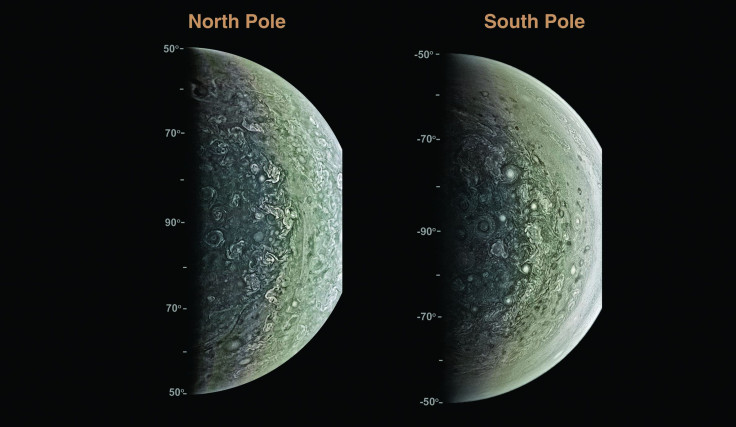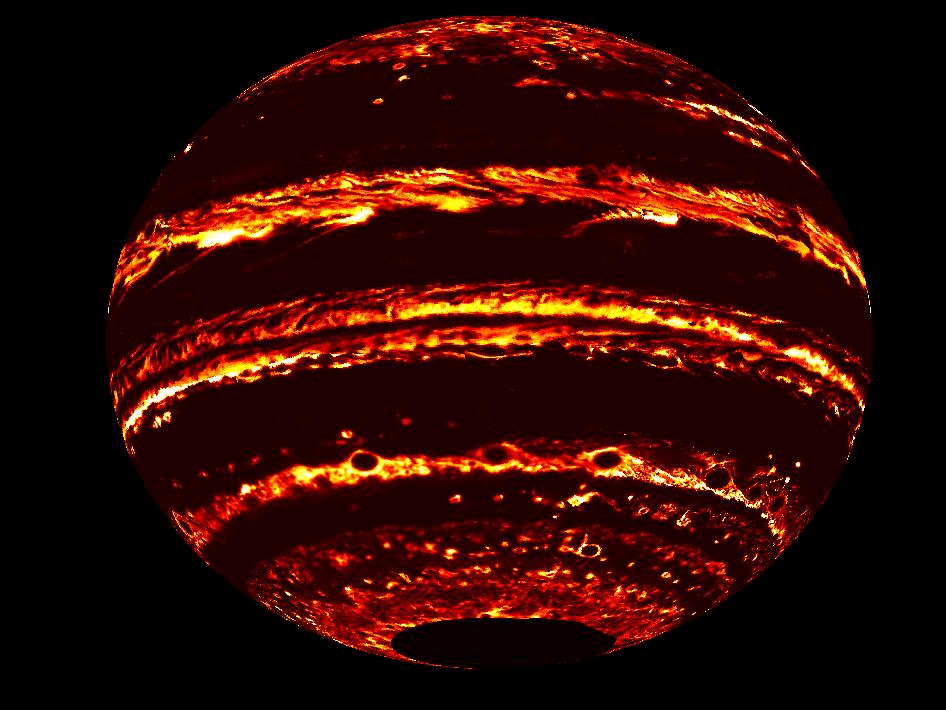Jupiter’s Chaotic Cyclones, Massive Magnetism Revealed In First Juno Results

It took NASA’s Juno spacecraft about five years to reach Jupiter, the largest planet in our solar system. And after it made its first pass around the gas giant Aug. 27, 2016, another nine months had to pass before scientists could analyze the data collected on that maiden flyby and present it to the public.
Two papers published Thursday in the journal Science provide insights into Jupiter’s atmosphere and interior. The planet’s poles are rife with chaotic cyclones and its magnetic field is much stronger than predicted by models. The gigantic planet’s magnetosphere was likely expanding when Juno first entered it June 24, 2016. And its aurora, seen in ultraviolet and infrared, are possibly caused by a rain of electron beams.
Read: Juno Captures Ghostly Sounds From Jupiter’s Auroras
One of the papers, titled “Jupiter’s interior and deep atmosphere: The initial pole-to-pole passes with the Juno spacecraft,” uses data collected by Juno during its passes over the planet’s poles. The “chaotic scene of bright oval features” seen at both the north and south poles are very different from polar activity seen on neighboring Saturn, according to a statement Thursday by the American Association for the Advancement of Science (publishers of the journal Science).
Juno captured time-lapse images of Jupiter’s polar regions, and discovered the ovals to be cyclones, some of which are up to 1,400 kilometers (870 miles) across in diameter.
As it passed over the cloud tops of Jupiter, Juno also measured the planet’s deep atmosphere’s thermal structure. The formation of giant weather systems and unexpected structures was put down by the paper’s authors as being caused by the welling up of ammonia from the deep atmosphere.
Models predict that the gas giant has a solid metal core, and measurements made by Juno are expected to help verify or invalidate the theory. But an analysis of the planet’s magnetic field found it to be far stronger than predicted by models. At 7.766 gauss, it is well over 10 times stronger than Earth’s magnetic field.
Read: Juno Sends First Photograph From Jupiter Orbit
The second paper was titled “Jupiter’s magnetosphere and aurorae observed by the Juno spacecraft during its first polar orbits.” Its authors said the fact that Juno encountered only one bow shock (a stationary shockwave, created at the point where the incoming solar wind is repelled by the planet’s magnetic field) when entering Jupiter’s magnetosphere, compared to the numerous encounters during later orbits, suggested the magnetosphere was growing in size at the time of first contact.

From its perspective above the poles, Juno also detected something akin to a rain of electron beams that shower energy into Jupiter’s upper atmosphere. That is a likely cause for the huge aurorae Juno captured in ultraviolet and infrared. The distribution of the electron showers, however, is very different from those responsible for causing aurorae on Earth.
The first study was led by Scott Bolton of Southwest Research Institute, San Antonio, Texas, who is the principal investigator for the Juno mission. The leader for the second study was John Connerney, who is with NASA’s Sciences and Exploration Directorate. Open-access copies of both papers are available on the journal’s website. A number of related articles are also available on the website of the journal Geophysical Research Letters.
© Copyright IBTimes 2024. All rights reserved.





















